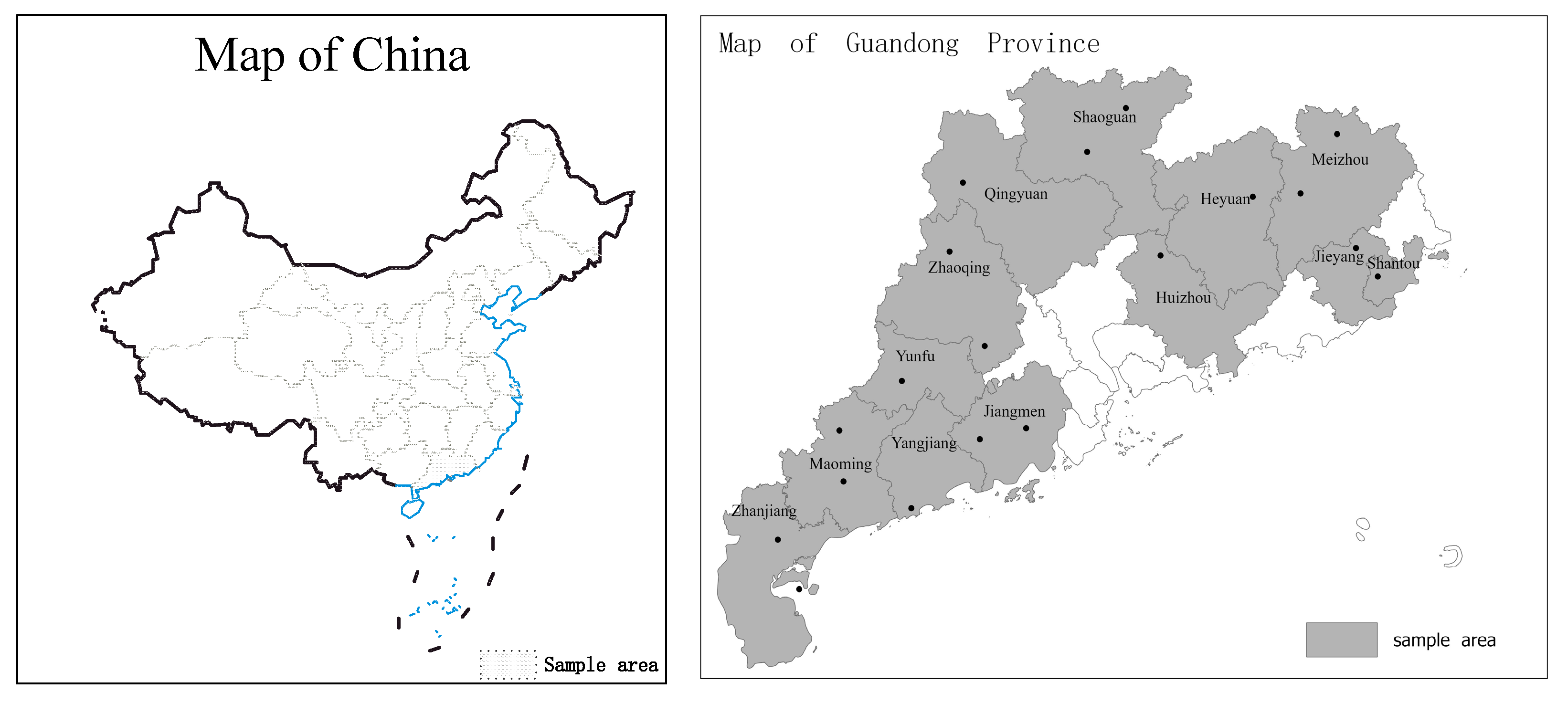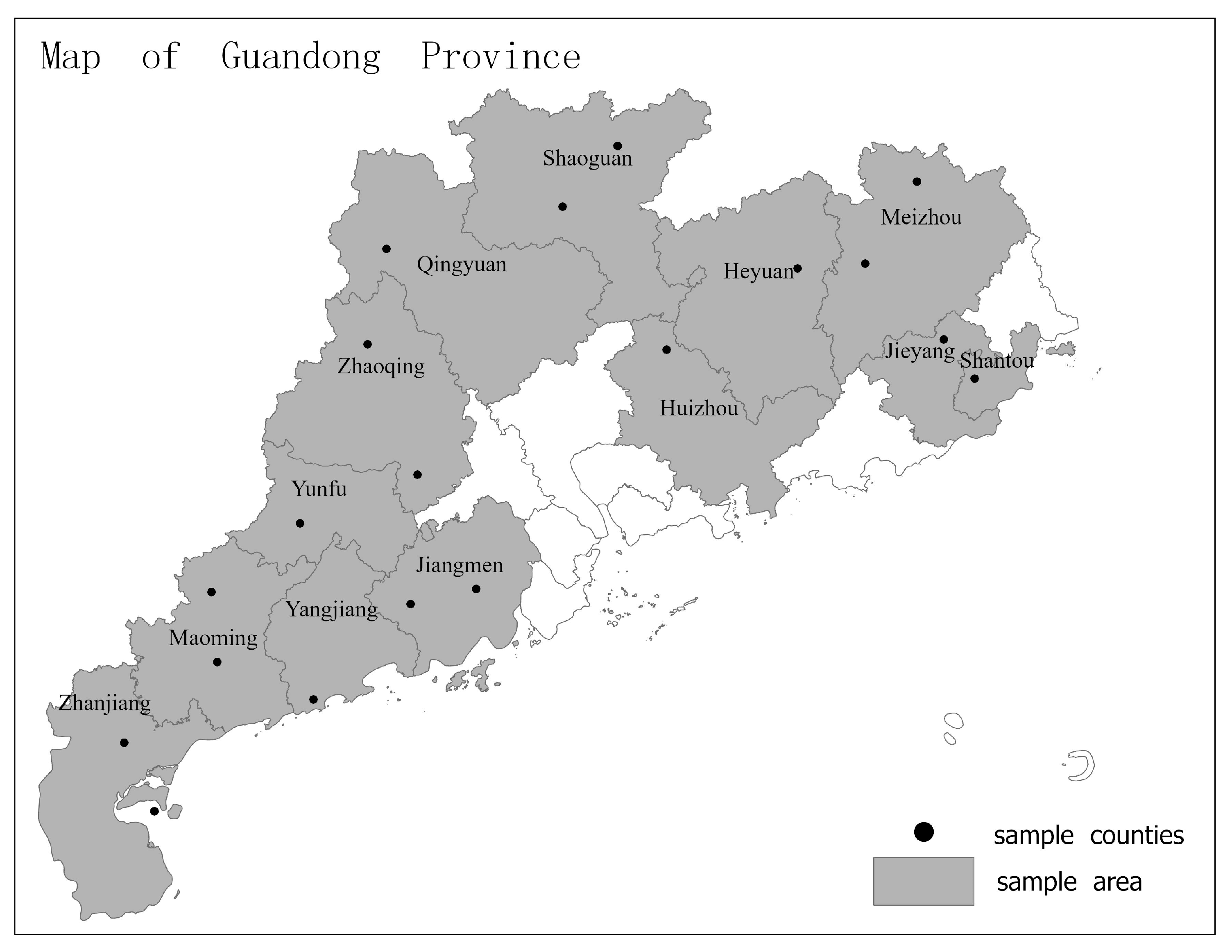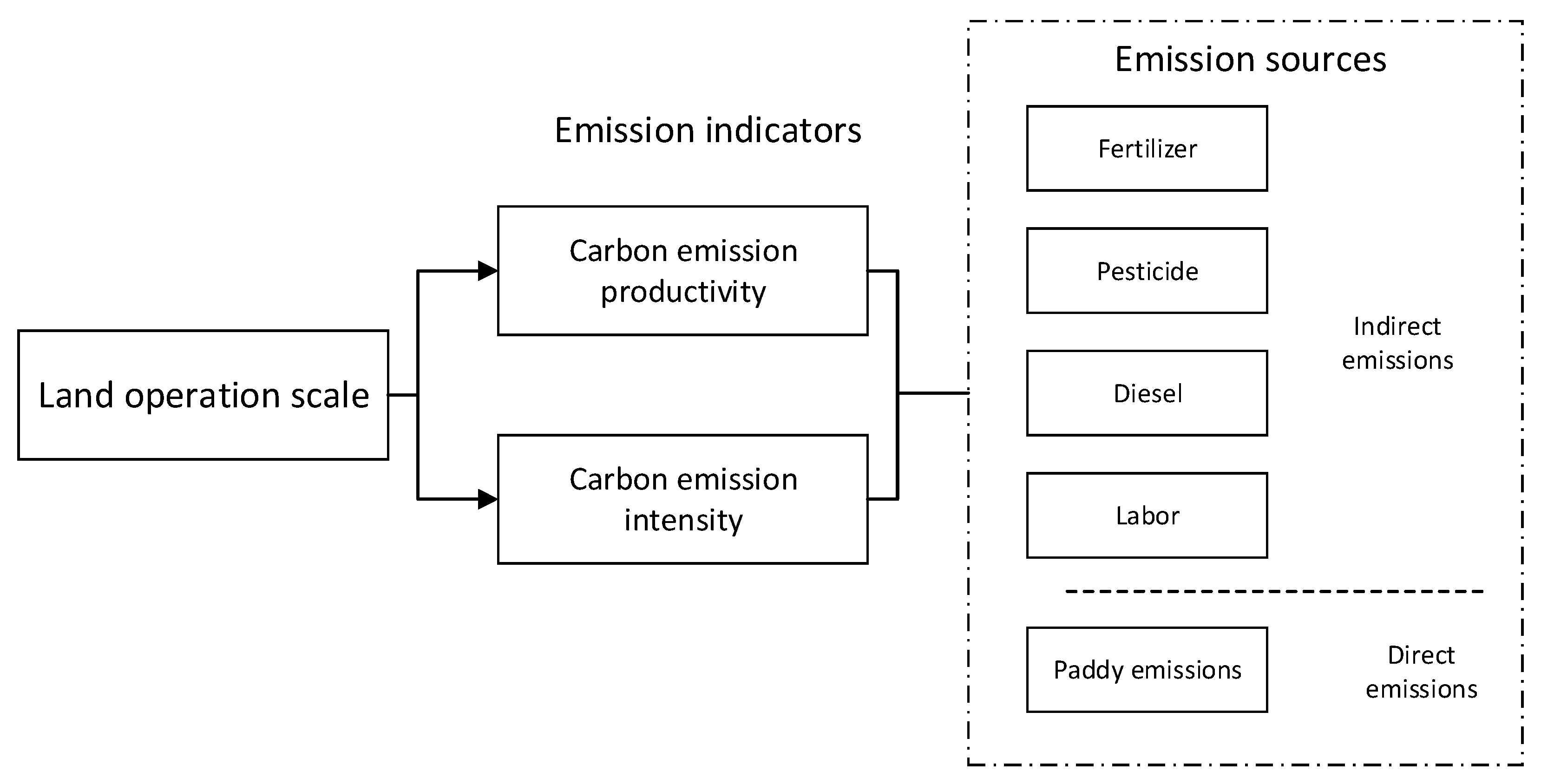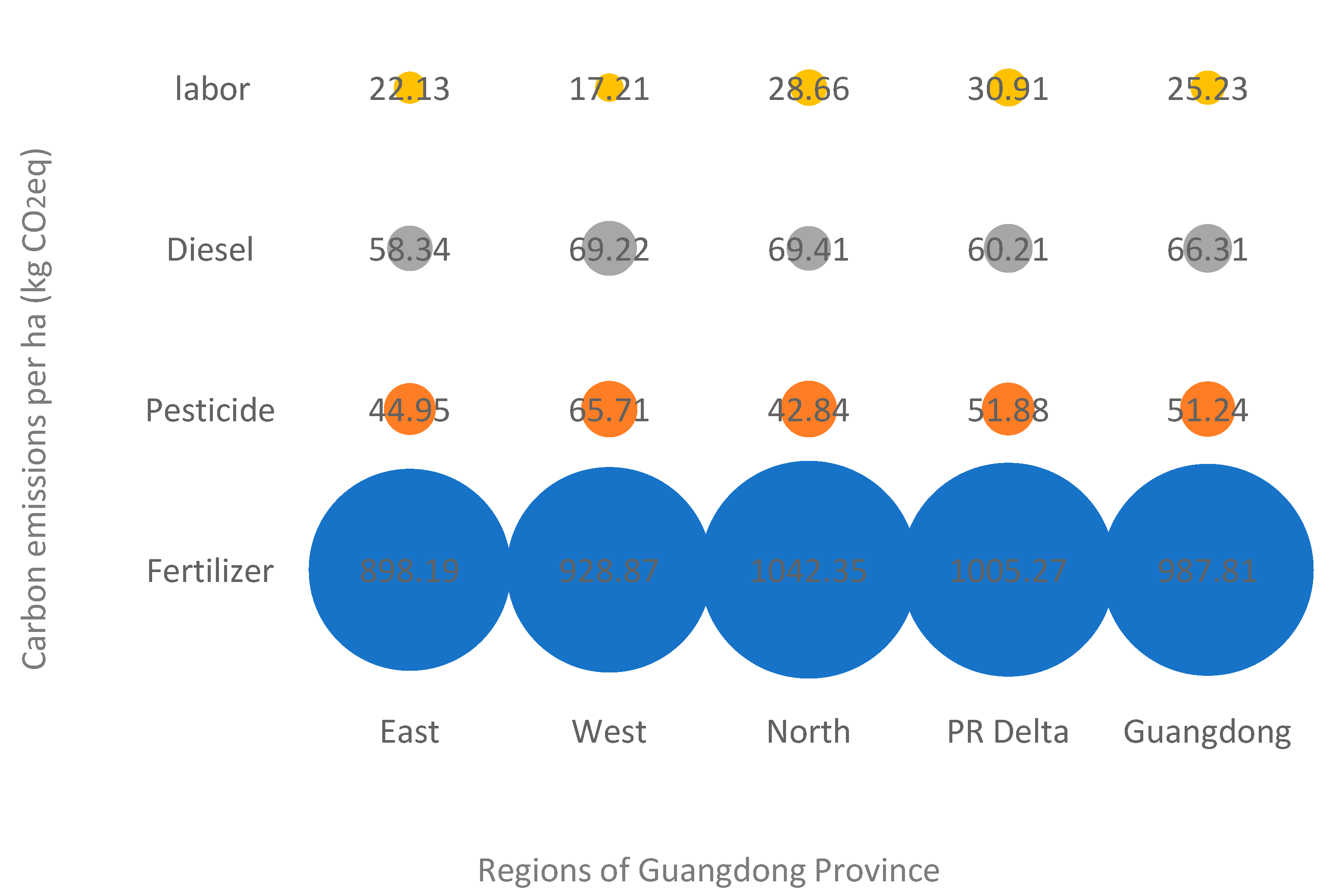Does Land Operation Scale Improve Rice Carbon Emission Productivity? Evidence from 916 Farmers in Guangdong Province, China
Abstract
1. Introduction
2. Materials and Methods
2.1. Overview of the Study Area and Data Source
2.2. Theoretical Analysis and Research Hypothesis
2.3. Variable Selection
2.4. Data Description
2.5. Carbon Emission Calculation
2.5.1. Carbon Emissions from Factors Input
2.5.2. Carbon Emissions from Paddy Field
2.5.3. Rice Production Carbon Emission Productivity and Carbon Emission Intensity
2.6. Econometric Model
3. Results
3.1. Carbon Emissions of Rice Production
3.2. Impact of Land Operation Scale on Carbon Emissions of Rice Production
3.2.1. Impact of Land Operation Scale on Carbon Emission Productivity
3.2.2. Impact of Land Operation Scale on Carbon Emission Intensity
4. Discussion
5. Conclusions
Author Contributions
Funding
Institutional Review Board Statement
Informed Consent Statement
Data Availability Statement
Acknowledgments
Conflicts of Interest
References
- IPCC. Climate Change 2014: The Fifth Assessment Report of the Intergovernmental Panel on Climate Change; IPCC: Geneva, Switzerland, 2014. [Google Scholar]
- FAO (Food and Agriculture Organization of the United Nations). Statistics of Rice Production in 2019 Based on Continent; FAO Statistical Database; FAO: Rome, Italy, 2019. [Google Scholar]
- NBS (National Bureau of Statistics of China). Announcement of the National Bureau of Statistics on Grain Production Data for 2024. Available online: https://www.stats.gov.cn/sj/zxfb/202412/t20241213_1957744.html (accessed on 10 June 2025).
- Yan, M.; Cheng, K.; Luo, T.; Yan, Y.; Pan, G.; Rees, R.M. Carbon footprint of grain crop production in China—Based on farm survey data. J. Clean. Prod. 2015, 104, 130–138. [Google Scholar] [CrossRef]
- Beinhocker, E.; Oppenheim, J.; Irons, B.; Lahti, M.; Farrell, D.; Nyquist, S.; Remes, J.; Nauclér, T.; Enkvist, P.-A. The Carbon Emission Productivity Challenge: Curbing Climate Change and Sustaining Economic Growth; McKinsey & Company: Sydney, Australia, 2008. [Google Scholar]
- NBS (National Bureau of Statistics of China). The Total Population Has Slightly Decreased, and the Level of Urbanization Continues to Increase. Available online: http://www.stats.gov.cn/xxgk/jd/sjjd2020/202301/t20230118_1892285.html (accessed on 20 December 2023).
- Zhu, Y.; Waqas, M.A.; Li, Y.; Zou, X.; Jiang, D.; Wilkes, A.; Qin, X.; Gao, Q.; Wan, Y.; Hasbagan, G. Large-scale farming operations are win-win for grain production, soil carbon storage and mitigation of greenhouse gases. J. Clean. Prod. 2018, 172, 2143–2152. [Google Scholar] [CrossRef]
- Zhang, W.; Zhang, Y.; Deng, A.; Zhang, J. Integrated impacts and trend analysis of rice cultivar renewal and planting technology improvement on carbon emission in China. China Rice 2021, 27, 53–57. [Google Scholar]
- Xu, X.; Zhou, Z.; Sun, M.; Bai, Y.; Zhang, L. Dual growth of green total factor productivity and greenhouse gas emission intensity of smallholder farms in China: Trends and misallocation. Resour. Conserv. Recycl. 2025, 222, 108421. [Google Scholar] [CrossRef]
- Zhang, Z.; Mu, Y. Can industrial agglomeration improve agricultural carbon emission productivity? China Popul. Resour. Environ. 2019, 29, 57–65. [Google Scholar]
- Luo, B. Agricultural modernization in China: Development context, goal setting and strategic options. J. Mod. Stud. 2023, 2, 65–78. [Google Scholar]
- West, P.; Gerber, J.; Engstrom, P.; Mueller, N.D.; Brauman, K.A.; Carlson, K.M.; Cassidy, E.S.; Johnston, M.; MacDonald, G.K.; Ray, D.K.; et al. Leverage points for improving global food security and the environment. Science 2014, 345, 325–328. [Google Scholar] [CrossRef] [PubMed]
- Adewale, C.; Reganold, J.; Higgins, S.; Higgins, S.; Evans, R.D.; Carpenter-Boggs, L. Agricultural carbon footprint is farm specific: Case study of two organic farms. J. Clean. Prod. 2019, 229, 795–805. [Google Scholar] [CrossRef]
- Unakitan, G.; Hurma, H.; Yilmaz, F. An analysis of energy use efficiency of canola production in Turkey. Energy 2010, 35, 3623–3627. [Google Scholar] [CrossRef]
- Arunrat, N.; Pumijumnong, N.; Sereenonchai, S.; Chareonwong, U.; Wang, C. Comparison of GHG emissions and farmers’ profit of large-scale and individual farming in rice production across four regions of Thailand. J. Clean. Prod. 2021, 278, 123945. [Google Scholar] [CrossRef]
- Ortiz-Gonzalo, D.; Vaast, P.; Oelofse, M.; Neergaard, A.; Albrecht, A.; Rosenstock, T.S. Farm-scale greenhouse gas balances, hotspots and uncertainties in smallholder crop-livestock systems in Central Kenya. Agric. Ecosyst. Environ. 2017, 248, 58–70. [Google Scholar] [CrossRef]
- Liu, Q.; Xiao, H. What is the logic behind the impact of agricultural land management scale on agricultural carbon emissions?—The mediating effect of factors input and the moderating effect of personal quality. Rural Econ. 2020, 5, 10–17. [Google Scholar]
- Bai, J.; Liu, J.; Ma, L.; Zhang, W. The impact of farmland management scale on carbon emissions. Land 2023, 12, 1760. [Google Scholar] [CrossRef]
- Liu, N.; Hu, H.; Hu, Y. Research on structural characteristics and affecting factors of carbon emission of rice production in Jiangsu Province—Based on farmers’ factors input and scale. J. Anhui Agric. Sci. 2014, 42, 4121–4124. [Google Scholar]
- Huang, Q.; Zhang, Y. Decoupling and decomposition analysis of agricultural carbon emissions: Evidence from Heilongjiang Province, China. Int. J. Environ. Res. Public Health 2022, 19, 198. [Google Scholar] [CrossRef]
- Xiong, C.; Wang, G.; Su, W.; Gao, Q. Selecting low-carbon technologies and measures for high agricultural carbon productivity in Taihu Lake Basin, China. Environ. Sci. Pollut. Res. 2021, 28, 49913–49920. [Google Scholar] [CrossRef]
- Wu, Y.; Xi, X.; Tang, X.; Luo, D.; Gu, B.; Lam, S.K.; Vitousek, P.M.; Chen, D. Policy distortions, farm size, and the overuse of agricultural chemicals in China. Proc. Natl. Acad. Sci. USA 2018, 115, 7010–7015. [Google Scholar] [CrossRef]
- Xie, D.; Gao, W. Low-carbon transformation of China’s smallholder agriculture: Exploring the role of farmland size expansion and green technology adoption. Environ. Sci. Pollut. Res. 2023, 30, 105522–105537. [Google Scholar] [CrossRef]
- Xu, X.; Li, C.; Guo, J.; Zhang, L. Land transfer-in scale, land operation scale and carbon emissions from crop planting throughout the life cycle: Evidence from China rural development survey. China Rural Econ. 2022, 11, 40–58. [Google Scholar]
- Qiu, T.; Choy, S.; Li, Y.; Luo, B.; Li, J. Farmers’ exit from land operation in rural China: Does the price of agricultural mechanization services matter? China World Econ. 2021, 29, 99–122. [Google Scholar] [CrossRef]
- IPCC. IPCC Guidelines for National Greenhouse Gas Inventories, Volume 4: Agriculture, Forestry and Other Land Use; IPCC: Geneva, Switzerland, 2006. [Google Scholar]
- Ju, X.; Gu, B.; Wu, Y.; Galloway, J. Reducing China’s fertilizer use by increasing farm size. Glob. Environ. Chang. 2016, 41, 26–32. [Google Scholar] [CrossRef]
- Fan, L.; Niu, H.; Yang, X.; Qin, W.; Bento, C.P.; Ritsema, C.J.; Geissen, V. Factors affecting farmers’ behaviour in pesticide use: Insights from a field study in northern China. Sci. Total Environ. 2015, 537, 360–368. [Google Scholar] [CrossRef] [PubMed]
- Wu, H.; Hao, H.; Lei, H.; Ge, Y.; Shi, H.; Song, Y. Farm size, risk aversion and overuse of fertilizer: The heterogeneity of large-scale and small-scale wheat farmers in Northern China. Land 2021, 10, 111. [Google Scholar] [CrossRef]
- Liao, L.; Long, H.; Ma, E. Changes of rural labor factors and transformation of cultivated land use. Econ. Geogr. 2021, 41, 148–155. [Google Scholar]
- Xia, L.; Ti, C.; Li, B.; Xia, Y.; Yan, X. Greenhouse gas emissions and reactive nitrogen releases during the life-cycles of staple food production in China and their mitigation potential. Sci. Total Environ. 2016, 556, 116–125. [Google Scholar] [CrossRef]
- Chen, S.; Liu, T.; Cao, C.; Ling, L.; Wang, B. Situation of carbon neutrality in rice planting and techniques for low-carbon rice farming. J. Huazhong Agric. Univ. 2021, 40, 3–12. [Google Scholar]
- Chen, L.; Yan, M.; Pan, G. Evaluation of the carbon footprint of greenhouse vegetable production based on questionnaire survey from Nanjing, China. J. Agro-Environ. Sci. 2011, 30, 1791–1796. [Google Scholar]
- Min, J.; Hu, H. Calculation of greenhouse gases emission from agriculture production in China. China Popul. Resour. Environ. 2012, 22, 21–27. [Google Scholar]
- Cao, L.; Li, M.; Wang, X.; Zhao, Z.; Pan, X. Life cycle assessment of carbon footprint for rice planting in Shanghai. Acta Ecol. Sin. 2014, 34, 491–499. [Google Scholar]
- Wang, M.; Li, J.; Zheng, X. Methane emission and mechanisms of methane production, oxidation, transportation in the rice fields. Chin. J. Atmos. Sci. 1998, 4, 600–612. [Google Scholar]
- IPCC. Climate Change 2013: The Physical Science Basis; Cambridge University Press: New York, NY, USA, 2013. [Google Scholar]
- Liu, Y.; Zhang, J.B.; Zhang, L. Analysis of carbon emission efficiency of rice in China under different rice planting patterns based on the DEA-SBM model. J. China Agric. Univ. 2018, 23, 177–186. [Google Scholar]
- OECD. Green Growth Indicators for Agriculture; OECD Publishing: Paris, France, 2014. [Google Scholar]
- Ma, L.; Feng, S.; Reidsma, P.; Qu, F.; Heerink, N. Identifying entry points to improve fertilizer use efficiency in Taihu Basin, China. Land Use Policy 2014, 37, 52–59. [Google Scholar] [CrossRef]
- Baldoni, E.; Coderoni, S.; Esposti, R. The productivity and environment nexus with farm-level data. Bio-Based Appl. Econ. 2017, 6, 119–137. [Google Scholar]
- Coderoni, S.; Vanino, S. The farm-by-farm relationship among carbon productivity and economic performance of agriculture. Sci. Total Environ. 2022, 819, 153103. [Google Scholar] [CrossRef]
- Ren, C.; Liu, S.; Grinsven, H.; Qu, F.; Heerink, N. The impact of farm size on agricultural sustainability. J. Clean. Prod. 2019, 220, 357–367. [Google Scholar] [CrossRef]
- Yu, Y.; Hu, Y.; Gu, B.; Reis, S.; Yang, L. Reforming smallholder farms to mitigate agricultural pollution. Environ. Sci. Pollut. Res. 2022, 29, 13869–13880. [Google Scholar] [CrossRef]




| Variables | Definition | Mean | Std. Dev. | Min | Max |
|---|---|---|---|---|---|
| Age | Age (year) | 59.60 | 9.671 | 28 | 87 |
| Gender | 1 = man; 0 = woman | 0.723 | 0.448 | 0 | 1 |
| Education level | Years of schooling (year) | 6.952 | 3.393 | 0 | 16 |
| Health status | 1 = excellent; 2 = acceptable; 3 = poor | 1.289 | 0.552 | 1 | 3 |
| Village cadre | 1 = yes; 0 = no | 0.093 | 0.290 | 0 | 1 |
| Farming experience | Years of farming (year) | 35.60 | 15.08 | 0 | 75 |
| Usage of smartphone | 1 = yes; 0 = no | 0.701 | 0.458 | 0 | 1 |
| Operational scale | Family’s operational scale of rice paddy (ha) | 0.472 | 0.965 | 0.07 | 16.39 |
| Family income | Family income of 2020 (CNY) | 78,763 | 104,640 | 1 | 2,013,000 |
| Family size | Population of the family | 5.550 | 2.474 | 1 | 18 |
| Living size | Size of living place (m2) | 223.2 | 187.8 | 12 | 2805 |
| Region | 1 = East region; 2 = West region; 3 = North region; 4 = Pear River Delta | 2.709 | 0.910 | 1 | 4 |
| ≥2 ha | 1–2 ha | 0.5–1 ha | 0.25–0.5 ha | 0.125–0.25 ha | <0.125 ha | |
|---|---|---|---|---|---|---|
| Number of farmers | 31(3.38%) | 42 (4.59%) | 118 (12.88%) | 292 (31.88%) | 293 (31.99%) | 140 (15.28%) |
| Emission Source Type | Emission Source | Emission Coefficient | Data Source | |
|---|---|---|---|---|
| Indirect emissions | Input of materials | Chemical fertilizer | 0.8956 kg CO2eq·kg−1 | Oak Ridge National Lab, US |
| Pesticide | 4.9341 kg CO2eq·kg−1 | |||
| Input of energy | Diesel | 0.5921 kg CO2eq·kg−1 | IPCC | |
| Labor | 0.25 kg CO2eq·day−1 | [33] | ||
| Direct emissions | Soil emissions | Paddy CH4 emissions (late rice in Guangdong, China) | 516 kgCH4·ha−1 | [34] |
| Unit | Mean | Std. Dev. | Min | Max | |
|---|---|---|---|---|---|
| Size | ha | 0.126 | 0.281 | 0.0067 | 4.667 |
| Yield | kg | 743.4 | 1535 | 45 | 28,000 |
| Market value of yield | CNY | 1234 | 3015 | 76.50 | 57,400 |
| Carbon emissions | kg CO2eq | 567.9 | 1247 | 29.01 | 21,547 |
| Indirect carbon emissions | kg CO2eq | 124.2 | 275.3 | 5.560 | 5129 |
| Yield carbon emission productivity | kg·kg CO2eq−1 | 1.347 | 0.316 | 0.578 | 2.361 |
| Yield value carbon emission productivity | CNY·kg CO2eq−1 | 2.166 | 0.635 | 0.714 | 4.562 |
| Carbon emission intensity | kg CO2eq·ha−1 | 4649 | 545.1 | 3670 | 6826 |
| Carbon Emission Source Type | Carbon Emission Source | Mean (kg CO2eq·ha−1) | Std. Dev. | Percentage in Total Carbon Emissions (%) | Percentage in Indirect Carbon Emissions (%) | |
|---|---|---|---|---|---|---|
| Indirect carbon emissions | Material input | Fertilizer | 987.81 | 524.08 | 21.25 | 87.37 |
| Pesticide | 66.31 | 42.37 | 1.43 | 5.87 | ||
| Energy input | Diesel | 51.24 | 46.04 | 1.11 | 4.53 | |
| Labor | 25.23 | 26.06 | 0.53 | 2.23 | ||
| Direct carbon emissions | Paddy emission (late rice) | CH4 | 3518.18 | 0 | 75.68 | - |
| Total | 4648.77 | 545.13 | 100.00 | 100.00 | ||
| Variables | Yield Indirect Carbon Emission Productivity | Yield Value Indirect Carbon Emission Productivity | ||||
|---|---|---|---|---|---|---|
| Model 1 | Model 2 | Model 3 | Model 4 | Model 5 | Model 6 | |
| Scale | 0.399 *** | 0.408 *** | 0.557 * | 0.603 ** | 0.574 ** | 1.198 ** |
| (2.64) | (2.65) | (1.75) | (2.30) | (2.17) | (2.20) | |
| Scale × Scale | - | - | −0.014 | - | - | −0.057 |
| - | - | (−0.54) | - | - | (−1.31) | |
| Age | - | −0.023 | −0.022 | - | −0.046 | −0.044 |
| - | (−0.99) | (−0.97) | - | (−1.17) | (−1.12) | |
| Gender | - | −0.029 | −0.030 | - | 0.070 | 0.066 |
| - | (−0.08) | (−0.08) | - | (0.11) | (0.11) | |
| Education level | - | 0.010 | 0.009 | - | 0.008 | 0.006 |
| - | (0.20) | (0.19) | - | (0.10) | (0.07) | |
| Health status | - | 0.540 * | 0.539 * | - | 0.846 * | 0.842 * |
| - | (1.95) | (1.95) | - | (1.78) | (1.77) | |
| Village cadre | - | −0.084 | −0.102 | - | −0.275 | −0.348 |
| - | (−0.16) | (−0.20) | - | (−0.31) | (−0.39) | |
| Farming experience | - | 0.003 | 0.003 | - | 0.006 | 0.004 |
| - | (0.23) | (0.19) | - | (0.26) | (0.16) | |
| Usage of smartphone | - | 0.311 | 0.309 | - | 0.345 | 0.334 |
| - | (0.84) | (0.83) | - | (0.54) | (0.52) | |
| Family size | - | −0.064 | −0.062 | - | −0.206 * | −0.200 * |
| - | (−1.03) | (−1.01) | - | (−1.93) | (−1.87) | |
| Living size | - | −0.000 | −0.000 | - | 0.001 | 0.001 |
| - | (−0.22) | (−0.21) | - | (0.39) | (0.40) | |
| Ln (family income) | - | 0.110 | 0.103 | - | 0.321 * | 0.288 |
| - | (1.06) | (0.97) | - | (1.79) | (1.59) | |
| Region | - | −0.613 *** | −0.623 *** | - | −0.602 ** | −0.641 ** |
| - | (−3.74) | (−3.78) | - | (−2.14) | (−2.26) | |
| Constant | 6.730 *** | 7.881 *** | 7.928 *** | 10.904 *** | 11.242 *** | 11.437 *** |
| (40.98) | (4.47) | (4.49) | (38.79) | (3.71) | (3.77) | |
| R-squared | 0.007 | 0.032 | 0.033 | 0.006 | 0.023 | 0.025 |
| Variables | Indirect Carbon Emission Intensity | Carbon Emission Intensity | |||
|---|---|---|---|---|---|
| Model 7 | Model 8 | Model 9 | Model 10 | Model 11 | |
| Scale | −66.946 *** | −61.978 *** | −138.954 *** | −126.158 *** | −126.158 *** |
| (−3.61) | (−3.32) | (37.574) | (−3.28) | (−3.28) | |
| Scale × Scale | - | - | 6.722 ** | 5.908 * | 5.908 * |
| - | - | (3.053) | (1.91) | (1.91) | |
| Age | - | 2.628 | - | 2.418 | 2.418 |
| - | (0.95) | - | (0.88) | (0.88) | |
| Gender | - | 38.970 | - | 39.429 | 39.429 |
| - | (0.90) | - | (0.91) | (0.91) | |
| Education level | - | −4.814 | - | −4.544 | −4.544 |
| - | (−0.85) | - | (−0.81) | (−0.81) | |
| Health status | - | −36.865 | - | −36.389 | −36.389 |
| - | (−1.10) | - | (−1.09) | (−1.09) | |
| Village cadre | - | −87.618 | - | −80.054 | −80.054 |
| - | (−1.39) | - | (−1.27) | (−1.27) | |
| Farming experience | - | −1.216 | - | −0.988 | −0.988 |
| - | (−0.76) | - | (−0.62) | (−0.62) | |
| Usage of smartphone | - | −34.138 | - | −32.980 | −32.980 |
| - | (−0.76) | - | (−0.73) | (−0.73) | |
| Family size | - | 6.926 | - | 6.300 | 6.300 |
| - | (0.92) | - | (0.84) | (0.84) | |
| Living size | - | 0.140 | - | 0.137 | 0.137 |
| - | (1.45) | - | (1.42) | (1.42) | |
| Ln (family income) | - | −37.880 *** | - | −34.466 *** | −34.466 *** |
| - | (−2.99) | - | (−2.70) | (−2.70) | |
| Region | - | 46.257 ** | - | 50.312 ** | 50.312 ** |
| - | (2.33) | - | (2.52) | (2.52) | |
| Constant | 1162.206 *** | 1342.101 *** | 1188.461 *** | 1322.103 *** | 4840.285 *** |
| (58.33) | (6.28) | (23.183) | (6.19) | (22.65) | |
| R-squared | 0.014 | 0.041 | 0.017 | 0.045 | 0.045 |
Disclaimer/Publisher’s Note: The statements, opinions and data contained in all publications are solely those of the individual author(s) and contributor(s) and not of MDPI and/or the editor(s). MDPI and/or the editor(s) disclaim responsibility for any injury to people or property resulting from any ideas, methods, instructions or products referred to in the content. |
© 2025 by the authors. Licensee MDPI, Basel, Switzerland. This article is an open access article distributed under the terms and conditions of the Creative Commons Attribution (CC BY) license (https://creativecommons.org/licenses/by/4.0/).
Share and Cite
Li, H.; Shi, M.; Li, S. Does Land Operation Scale Improve Rice Carbon Emission Productivity? Evidence from 916 Farmers in Guangdong Province, China. Land 2025, 14, 1750. https://doi.org/10.3390/land14091750
Li H, Shi M, Li S. Does Land Operation Scale Improve Rice Carbon Emission Productivity? Evidence from 916 Farmers in Guangdong Province, China. Land. 2025; 14(9):1750. https://doi.org/10.3390/land14091750
Chicago/Turabian StyleLi, Hui, Min Shi, and Shangpu Li. 2025. "Does Land Operation Scale Improve Rice Carbon Emission Productivity? Evidence from 916 Farmers in Guangdong Province, China" Land 14, no. 9: 1750. https://doi.org/10.3390/land14091750
APA StyleLi, H., Shi, M., & Li, S. (2025). Does Land Operation Scale Improve Rice Carbon Emission Productivity? Evidence from 916 Farmers in Guangdong Province, China. Land, 14(9), 1750. https://doi.org/10.3390/land14091750






